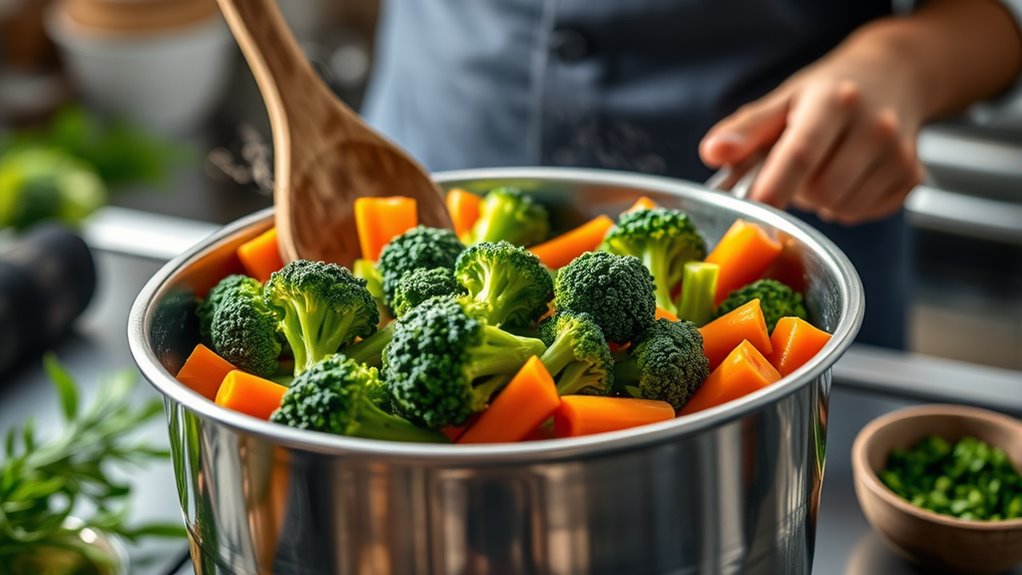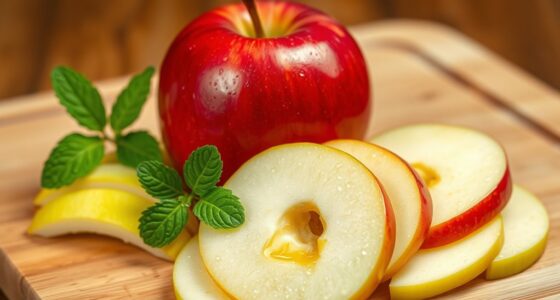To maximize vitamin retention, opt for gentle cooking methods like steaming or sautéing with minimal water, which help preserve nutrients, colors, and flavors. Keep cooking times short to prevent nutrient breakdown and aim for crisp-tender textures. Cutting vegetables into larger pieces can also reduce nutrient loss. Using the cooking water or avoiding overcooking guarantees vitamins like C and B are maintained. Continue exploring to reveal more tips for nutrient-rich cooking.
Key Takeaways
- Use steaming or minimal water boiling to cook vegetables gently and preserve water-soluble vitamins.
- Cut vegetables into larger pieces to reduce cooking time and nutrient loss.
- Keep cooking times short and monitor doneness to prevent overcooking and nutrient degradation.
- Recover nutrients by using cooking water in soups or sauces instead of discarding it.
- Opt for quick, gentle methods like steaming to maintain vibrant colors, flavors, and nutrient content.

Are you looking to maximize the health benefits of your meals? One of the simplest yet most effective ways to preserve the vitamins and minerals in your food is by focusing on your cooking methods. When it comes to vegetables, steaming vegetables and minimal water cooking are excellent choices. These techniques help retain water-soluble nutrients, such as vitamin C and B vitamins, which are often lost during traditional boiling.
Steaming vegetables involves cooking them with steam rather than submerging them in water. This method minimizes nutrient leaching because the vegetables are not directly exposed to water that can dissolve and carry away essential nutrients. You simply place your chopped vegetables in a steamer basket over boiling water, cover, and let the steam do its work. It’s quick, gentle, and highly effective at preserving the vibrant colors, flavors, and nutrients of your vegetables. Plus, steaming helps maintain the texture and natural sweetness, making your meals more appealing while boosting their nutritional profile.
Steaming preserves nutrients, colors, and flavors by cooking vegetables with steam instead of water.
Minimal water cooking, such as using the least amount of water necessary, is another technique that retains nutrients. When you cook vegetables in just enough water to cover them, you reduce the amount of nutrient loss that happens when excess water is discarded. For example, steaming or sautéing with a small splash of water allows the vegetables to cook thoroughly without soaking in large quantities of water that can cause vitamin depletion. If you do boil vegetables, consider using the cooking water in soups or sauces to recover any nutrients that leach out into the water.
Timing is also essential. Avoid overcooking vegetables, as extended heat exposure increases nutrient degradation. Keep the cooking time short and check for doneness frequently. For steaming, vegetables are often ready within just a few minutes, depending on the type and cut size. For minimal water cooking, aim for crisp-tender results, which help optimize nutrient retention.
Another tip is to cut vegetables into larger pieces before cooking. Smaller pieces cook faster and may lose nutrients more quickly. By keeping pieces larger, you reduce the overall cooking time and preserve more vitamins.
Frequently Asked Questions
How Does the Size of Vegetable Cuts Affect Nutrient Retention?
You’ll notice that smaller cuts of vegetables tend to increase nutrient loss because they expose more surface area to heat and air, which can break down vitamins. Larger cuts help retain more nutrients since there’s less surface area exposed during cooking. So, if you want to maximize vitamin retention, opt for bigger cuts or shorter cooking times. This way, you minimize cut size-related nutrient loss and preserve more of the veggie’s health benefits.
What Role Do Cooking Utensils Play in Preserving Vitamins?
Your choice of cooking utensils considerably impacts vitamin preservation. Use cooking vessel materials like stainless steel or cast iron, which don’t leach chemicals and help retain nutrients. Always prioritize utensil safety by avoiding non-stick coatings with harmful chemicals. Proper utensils guarantee even heat distribution and reduce nutrient loss. So, select quality, safe utensils that suit your cooking style, and handle them carefully to maximize vitamin retention in your meals.
Can Microwave Cooking Destroy Sensitive Nutrients?
Microwave cooking can cause some nutrient degradation, especially for sensitive vitamins like C and B. However, if you prioritize microwave safety by using appropriate containers and avoiding overheating, you can minimize nutrient loss. Quick cooking times and minimal water help preserve nutrients, making microwaves a convenient and relatively gentle method. Just be mindful of cooking duration to prevent unnecessary nutrient destruction, ensuring your meals retain maximum nutritional value.
Is It Better to Cook Vegetables With or Without Water?
Think of your vegetables as treasure chests of nutrients. When you cook them with water, like boiling, some of those treasures may escape into the water, like whispers lost in a storm. Steaming keeps the treasures locked inside, preserving more vitamins. So, steaming beats water-based cooking like boiling, because it gently shields your vegetables’ nutrients, letting you enjoy their full flavor and health benefits without letting precious vitamins wash away.
How Does Storage Before Cooking Impact Vitamin Levels?
Storing vegetables properly before cooking helps preserve their vitamin levels. Use airtight containers or keep them in the refrigerator to maintain nutrient stability and prevent spoilage. Avoid prolonged storage at room temperature, which can degrade sensitive vitamins like C and B. Fresh, well-stored vegetables retain more nutrients, so plan to cook them soon after purchase. Proper storage methods guarantee you maximize vitamin content and enjoy the health benefits of your vegetables.
Conclusion
By choosing the right cooking methods, you preserve essential nutrients and enjoy fresher flavors. While steaming or microwaving keeps vitamins intact, overcooking can drain your meals of health benefits. Remember, rushing through preparation diminishes the value of wholesome ingredients. Sometimes, taking a little extra time to cook gently is the difference between a nutritious meal and a missed opportunity. In nourishing your body, patience becomes your greatest tool—because what you save in time, you gain in health.









